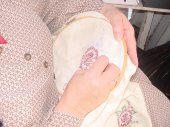|

No woman was exempt from the duties of sewing. From a very young age, girls were taught how to work with needle and thread to mend and make textiles. People of different levels of society, however, did different types of work. The poor did not have the money or the resources to do fine work, and therefore, did mostly darning and knitting. Knitting is very simple and only requires needles and yarn. Many poor families had sheep, so wool for knitting was easy to get. Darning was essential because poor families could not afford to replace a piece of clothing because of a rip. Everything had to be repaired until it was unusable.
The middle class had more money and could afford to buy supplies to undertake more elaborate projects. Women still knitted, but they also crocheted, quilted, and did simple embroidery. Decorative crafts were only done when the women had free time.
Upper class women had maids to do their housework for them and had plenty of time to engage in fine crafts. The upper class also had more money and could afford to buy silks and other materials for fine work. Women would do such things as fine embroidery, tatting, crocheting and crazy quilting. Crazy quilting was something only enjoyed by the rich because of the cost of silk used to make this type of quilt.
At Sherbrooke Village our guides demonstrate many of these types of handiwork in different buildings on site. Visitors are welcome to come and watch, and even try their hand at some of the crafts.
Click for more pictures

|

|
|